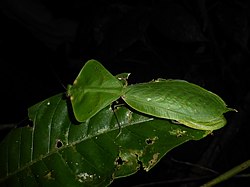| Choeradodis strumaria | |
|---|---|
 | |
| Male in French Guiana | |
| Scientific classification | |
| Kingdom: | Animalia |
| Phylum: | Arthropoda |
| Class: | Insecta |
| Order: | Mantodea |
| Family: | Mantidae |
| Genus: | Choeradodis |
| Species: | C. strumaria |
| Binomial name | |
| Choeradodis strumaria | |
| Synonyms | |
Choeradodis strumaria, common names leaf mantis and hooded mantis, is a species of praying mantis native to French Guiana and Suriname; although there have been reports from other, distant countries, these are considered erroneous. [1] [2]
